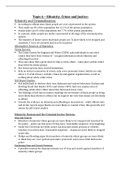Summary
Summary AQA A-level Sociology Student Guide 3: Crime and deviance with theory and methods, ISBN: 9781510472440 Crime and Deviance
- Module
- Crime and Deviance
- Institution
- AQA
Detailed textbook notes for Ethnicity, Crime and Justice for AQA ALevel Sociology, crime and deviance Detailed but concise and tailored to exam prep and questions
[Show more]




